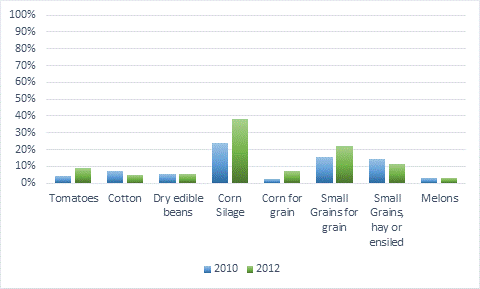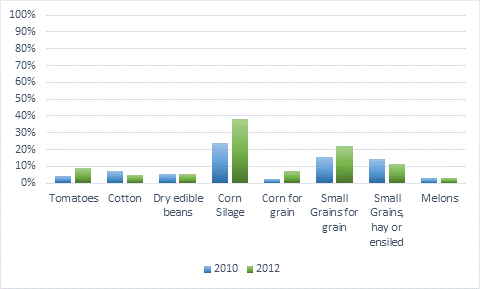Tillage practices continue to change
California's Conservation Agriculture Systems Innovation (CASI) Center, in partnership with Sustainable Conservation and the USDA Natural Resources Conservation Service, has prepared its survey of tillage management acreage for 2012. This tillage survey was conducted as an ongoing comparison of annual row crop acreage that is farmed under different tillage systems throughout the Central Valley region of California. Over 35 local NRCS, University of California and private sector experts were surveyed and results were compared with 2012 County Agricultural Commissioner cropland acreage reports. Previous surveys have been conducted in 2004, 2006, 2008 and 2010.
Data in this survey were compiled for two general types of reduced tillage systems. Tillage practices such as no-till, strip-till, ridge-till and mulch-till, that leave at least 30% of the residue from previous crops in place on the soil surface are the typical forms of conservation tillage that are recognized throughout the world and that have historically been chronicled as one category of reduced tillage in our survey. In addition to these practices, “minimum tillage” practices that reduce the overall number of tillage passes by at least 40% relative to what was done in the year 2000, are also included in the tally of conservation tillage acreage.
A number of complicating factors, including changes in cropping acreage and rotational crop selections that were being implemented in 2012 as California's drought began to take hold and changes and turnover in the local expert reporters who have provided input for the survey estimates over the years, may be apparent in the 2012 survey results. These methodological challenges notwithstanding, the 2012 survey has been carefully checked and represents a useful view to the ‘big picture' trends that may be occurring in the region and that may warrant more detailed investigations to determine why certain patterns are being noted.
In 2012, conservation tillage systems accounted for about 17% of the total acreage for the crops that were surveyed including silage and grain corn, small grains for hay, silage and grain, tomatoes, cotton, dry beans, and melons throughout the nine-county Central Valley region. This was an increase from about 14% in 2010. Minimum tillage practices were used on about 15% of crop acreage in 2012, a reduction from about 24% in 2010.
The largest change in conservation tillage acreage from 2004 – 2012 is found in the amount of corn silage acreage that uses strip-tillage. In 2004, there were only about 490 acres of summer silage corn using strip-till, while in 2012 over 181,000 acres throughout the San Joaquin Valley region had adopted the use of this form of conservation tillage. Another major trend during this time has occurred with minimum tillage tomato acreage increasing from about 3% in 2004, to about 58% in both 2010 and 2012. Speculation as to why minimum tillage acreage overall tended to decline from 2010 to 2012 may relate to issues with herbicide application practices as well as soil salinity patterns that occur particularly with subsurface drip irrigation that have become concerns for farmers if broadcast, full-area tillage is not performed. A full and detailed report of CASI's tillage acreage survey is available at our website: http://casi.ucanr.edu
|
Table 1. California conservation tillage acreage survey (2012) for tomatoes, cotton, edible dry beans, silage corn, grain corn, and small grains for grain, hay and silage, CT – conservation tillage, MT – minimum tillage, September 14, 2014 |
||||||
|
|
>30% residue cover after planting |
>40% reduction in total passes |
<30% residue cover after planting |
Total Acreage |
CT as a % of Total Acreage |
CT and MT as a % of Total Acreage |
|
|
Conservation Tillage Total |
Minimum Tillage Total |
Conventional Tillage |
|
|
|
|
|
|
|
|
|
|
|
|
County |
|
|
|
|
|
|
|
|
|
|
|
|
|
|
|
Fresno |
22,317 |
157,162 |
210,410 |
389,889 |
5.72 |
46.03 |
|
Kern |
2,108 |
18,862 |
171,413 |
192,383 |
1.1 |
10.9 |
|
Kings |
82,476 |
10,345 |
250,497 |
343,318 |
24.02 |
27.04 |
|
Madera |
19.330 |
2,708 |
38,562 |
60,600 |
31.9 |
37 |
|
Merced |
53,012 |
12,027 |
306,540 |
371,579 |
14.27 |
17.5 |
|
Sacramento |
1,009 |
13,500 |
34,600 |
49,109 |
2.05 |
29.54 |
|
San Joaquin |
|
38,908 |
258,022 |
296,930 |
0 |
13.1 |
|
Tulare |
142,826 |
14,766 |
262,639 |
420,230 |
33.99 |
37.5 |
|
Yolo |
49,260 |
58,983 |
1,976 |
110,219 |
44.69 |
98.21 |
|
|
|
|
|
|
|
|
|
Total |
372,337 |
327,261 |
1,544,659 |
2,234,257 |
|
|
|
Table 2. |
||||||||||||
|
Year |
Total Acreage |
Tomato Acreage |
Cotton Acreage |
Silage Corn |
||||||||
|
|
CT |
MT |
CT+MT |
CT |
MT |
CT+MT |
CT |
MT |
CT+MT |
CT |
MT |
CT+MT |
|
|
|
|
|
|
|
|
|
|
|
|
|
|
|
2010 |
14.67 |
24.4 |
38.0 |
4.4 |
58.3 |
62.7 |
7.1 |
16.1 |
23.2 |
24.1 |
10.4 |
34.5 |
|
|
|
|
|
|
|
|
|
|
|
|
|
|
|
2012 |
16.67 |
13.6 |
31.3 |
8.8 |
57.9 |
66.7 |
4.8 |
14.8 |
19.5 |
38.4 |
5.8 |
43.0 |
For additional information and of various forms of conservation tillage, please contact Jeff Mitchell at (559) 303-9689 or jpmitchell@ucdavis.edu. For information on the equipment rental program for strip-tillage and silage corn planting, contact Ladi Asgill (209) 604-6554 or lasgill@suscon.org.


